Giuseppe Pastore is an Italian artist whose journey into the world of painting began unexpectedly, unfolding into a profound exploration of color, movement, and self-expression. From his initial encounter with a blank canvas to his evolution as a self-taught painter, Giuseppe’s artistic trajectory is marked by spontaneity, experimentation, and a deep-rooted passion for creation.
Inspired by the interplay between chaos and order, his vibrant compositions invite viewers to embark on a journey of introspection and interpretation. Through his distinctive style and unwavering dedication to his craft, Giuseppe continues to push the boundaries of his creativity, forging a unique artistic identity that resonates with audiences worldwide…
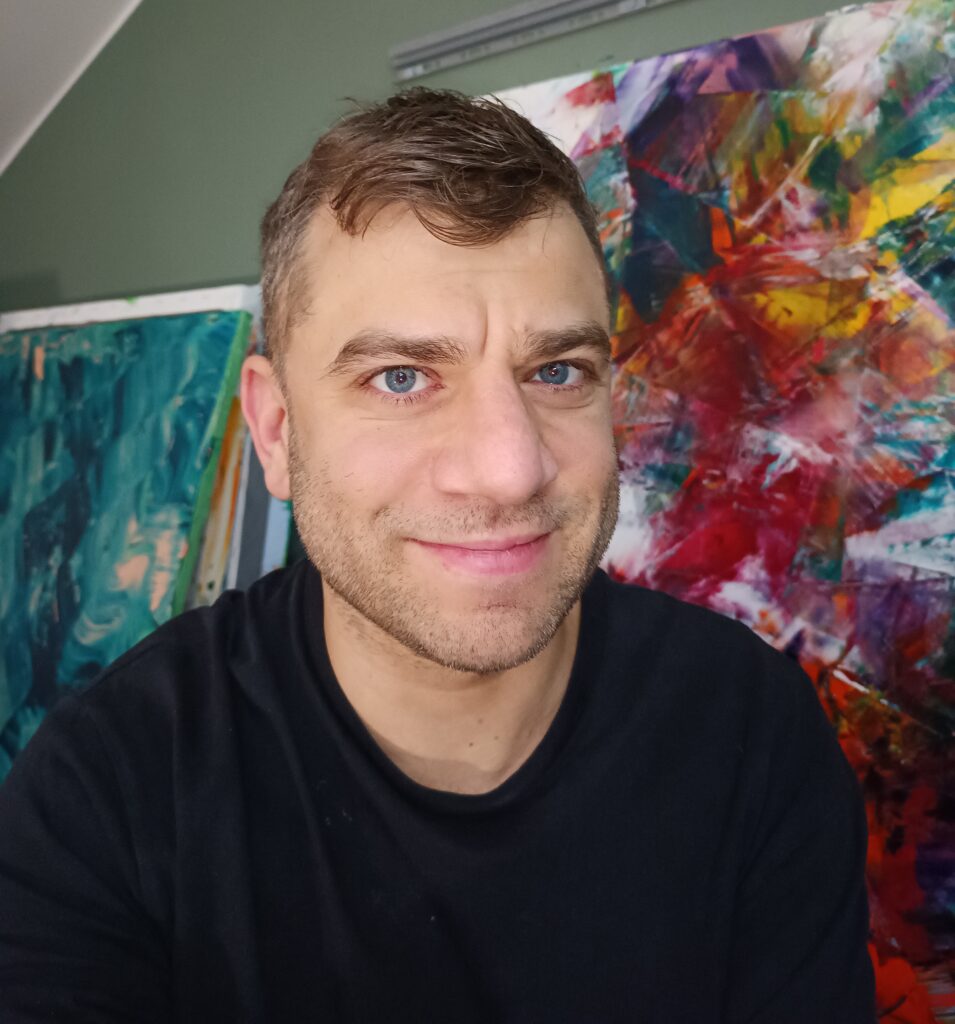
Can you tell us about the moment when you discovered your passion for painting and how it transformed from a chance encounter into a central part of your life?
It was an afternoon in 2010 when I found myself torn between going for a run or trying my hand at painting. Despite never having painted before, I had been intrigued by the idea of buying a canvas in the preceding days, yet hadn’t made the purchase. As I hesitated, my mother unearthed an old blank canvas, once belonging to my sister from her art school days. That day, I decided to paint, using the aged colors also belonging to my sister, now hardened and in need of thinning. Since then, driven by a compelling impulse, the need to paint has become a constant in my life. I’ve created over 250 paintings since that moment.
Your journey from studying Physics to becoming a self-taught painter is quite remarkable. How do you feel your scientific background influences your artistic process, if at all?
According to Leonardo da Vinci, “Art is science; it cannot be improvised and is not satisfied with indifferent and superficial approximations; on the contrary, it requires hard and systematic work.” I believe the scientific method has significantly influenced my approach to painting, particularly in the experimental phase of my early work. Subsequently, I’ve integrated acquired painting methodologies and techniques based on experiential learning. Just as in science, having a method has been fundamental to my artistic process, often involving unconventional tools such as DIY implements.
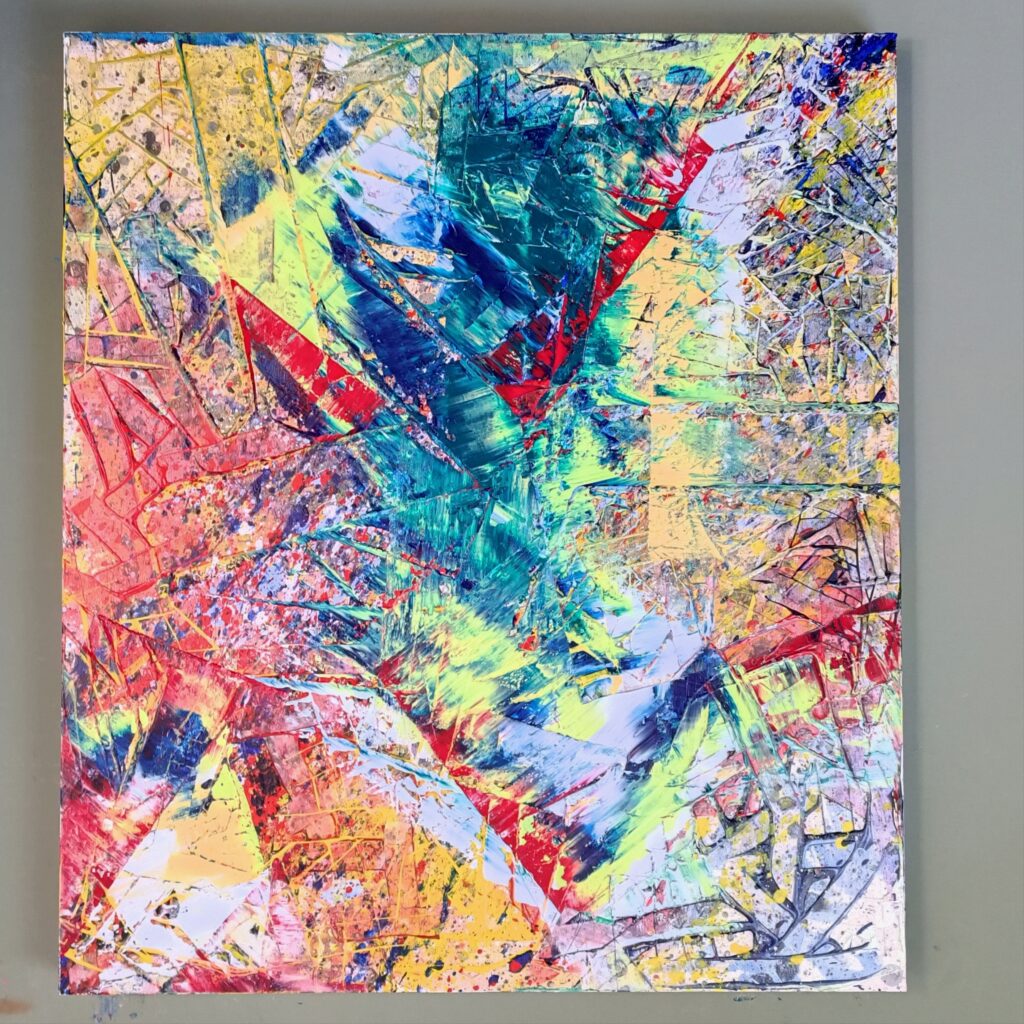
Your early works seem to explore themes of the infinite and depth. Could you delve into how these concepts emerged in your art and how they’ve evolved over time?
Themes of infinity and depth emerged spontaneously in my early works, such as “Opening” from 2012, where the concept of infinity is associated with depth. In other pieces like “T1” or “Lux Libera Nos,” infinity is depicted through repeated similar signs within the composition. Initially unplanned, the theme of infinity has evolved over time, transitioning into themes of movement in my recent oil paintings, characterized by geometrically unbounded motions as seen in “Tumulto.”
What role does spontaneity play in your creative process, particularly in your approach to action painting?
Identifying as an Action Painter, spontaneity is pivotal in my creative process. Almost all my paintings are gestural and spontaneous, often driven by the composition itself. This is particularly evident in my oil paintings, where canvases are laid horizontally and worked on from various angles. The application of color, often done with unconventional tools like spatulas, emphasizes movement and gesture. In this regard, my practice of traditional martial arts has also played a significant role.
The quote you’ve chosen from Khalil Gibran speaks to humility and the acceptance of ignorance. How does this philosophy resonate with you as an artist?
“I am ignorant of absolute truth. But I am humble before my ignorance and there lies my honor and my reward.” This quote resonates deeply with me as it underscores the humility required in both artistic and scientific pursuits. It acknowledges the relative nature of talent and the importance of continuous learning and growth. Embracing this philosophy allows artists to remain open to new possibilities and perpetually strive for improvement.
How do you balance instinct and deliberation in your artistic decisions, especially considering your transition from acrylics to mainly using oil paints?
Oil paints afford greater flexibility in reflection and adjustment compared to acrylics, which dry faster. Consequently, acrylic painting demands a more instinctive and swift approach, while oil painting allows for a more deliberate and thoughtful process. My transition from acrylics to oils has thus led to a shift towards more considered compositions, reflecting a balance between instinctive gestures and intentional decision-making.
As a self-taught artist, what challenges have you faced along your journey, and how have they shaped your artistic practice?
Being self-taught has allowed me to cultivate a unique perspective, less constrained by conventional artistic norms. However, it initially posed challenges in establishing authority within the art community and gaining recognition from traditional galleries. Instead, I’ve leveraged online platforms like Artfinder and Singulart to showcase my work. This journey has taught me to value originality and embrace diverse influences, shaping my practice into one that prioritizes personal expression over adherence to artistic conventions.
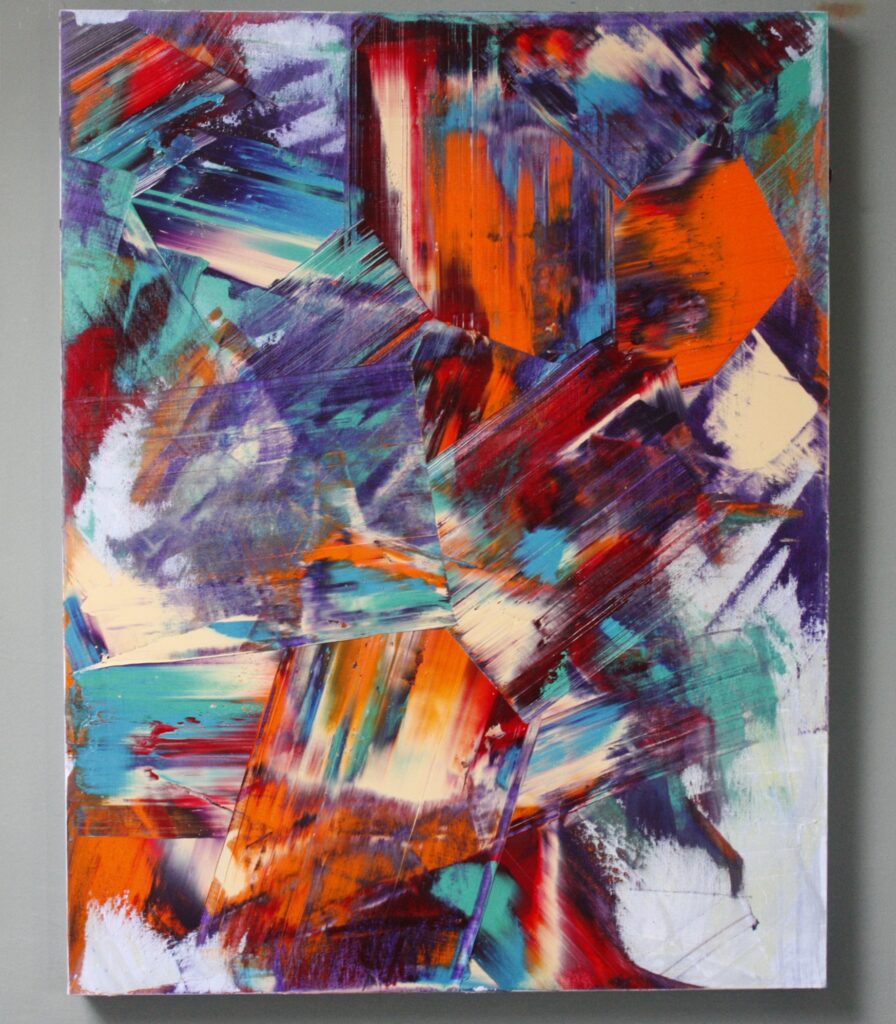
Your work seems to bridge the gap between chaos and order, with gestural movements meeting geometric themes. Can you discuss how you find harmony within this duality?
Chaos, often central to my paintings, should not be perceived negatively but rather as a dynamic force guided by underlying principles. While my compositions may appear chaotic, they are governed by intentional rules and harmonies developed over time. My expertise in color application allows me to create compositions that balance spontaneity with structure, evolving from geometrically precise forms to more fluid and dynamic arrangements.
Your art reflects a deep introspection and exploration of the self. What insights or revelations have you gained about yourself through your artistic endeavors?
Discovering my passion for painting later in life has been a revelation in itself, highlighting the unpredictability of personal discovery. Painting has provided me with a profound sense of satisfaction and fulfillment, offering a parallel avenue for creative expression alongside my scientific pursuits. Through this journey, I’ve come to appreciate the joy of creation and the inherent beauty of the artistic process.
How do you approach the concept of perfection in your art, especially considering the spontaneous nature of action painting?
Perfection, for me, is reached when I find myself satisfied with a painting, recognizing its inherent value and resonance. It’s not about achieving flawless execution but rather capturing a moment of creative fulfillment and resonance. Embracing the spontaneous nature of action painting allows me to appreciate imperfections as integral components of the artistic journey, each contributing to the unique character of the final piece.
Your paintings often seem to invite viewers to interpret and explore their own meanings. What do you hope audiences take away from experiencing your work?
I aim to provide viewers with a means of escape and introspection through my paintings, inviting them to immerse themselves in a world of color and movement. By offering space for personal interpretation, I hope to evoke emotions and spark contemplation, enabling viewers to find resonance and meaning within their own experiences.
How do you stay inspired and motivated, especially during periods of artistic block or self-doubt?
Fortunately, I haven’t experienced significant periods of artistic block or doubt. However, I find inspiration in classical music, particularly piano compositions by artists like Philip Glass, whose work resonates deeply with me. Additionally, immersing myself in nature and continuing my practice of traditional Japanese martial arts provides avenues for rejuvenation and creative inspiration.
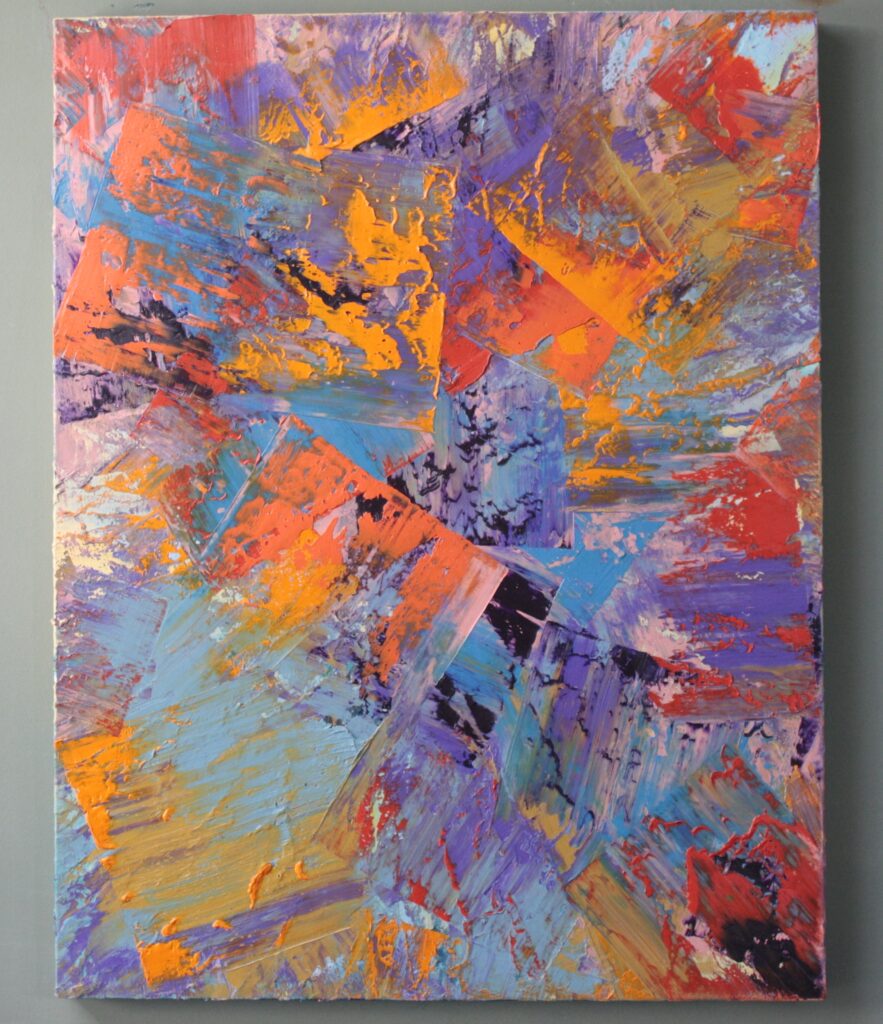
Your use of colour is both vibrant and nuanced. Could you share your thoughts on colour theory and its role in your compositions?
While I may not adhere to traditional color theory principles, I gravitate towards overlapping and blending colors in my oil paintings. Although my approach to color may be intuitive, there is a discernible method underlying my compositions, guided by years of experimentation and refinement. While I may not consciously adhere to established color theories, my compositions are nonetheless characterized by vibrant palettes and nuanced interplays of color and light.
What advice would you give to aspiring artists who are also embarking on a journey of self-discovery through their craft?
I would encourage aspiring artists to paint prolifically, embracing the journey of self-discovery and creative exploration. It’s essential not to be deterred by criticism but instead to view it as an opportunity for growth and refinement. Ultimately, the goal should be to derive joy and fulfilment from the act of painting itself, allowing passion and curiosity to guide the artistic journey.
Looking ahead, what are your aspirations and goals as an artist, and how do you see your work evolving in the future?
As an artist, my primary aspiration is to continue creating from a place of internal necessity, unconstrained by external expectations or ambitions for fame or success. While I hope to share my art with a broader audience, my focus remains on the intrinsic value of the creative process itself. Moving forward, I anticipate further exploration and evolution in my work, driven by an ongoing commitment to experimentation and personal growth.
Our readers love to travel. What destination is at the top of your bucket list?
Japan holds a special allure for me, given my passion for traditional Japanese martial arts and fascination with Eastern culture. While I may not travel extensively myself, preferring to let my paintings journey to new homes around the world, Japan remains a destination I hope to explore someday.
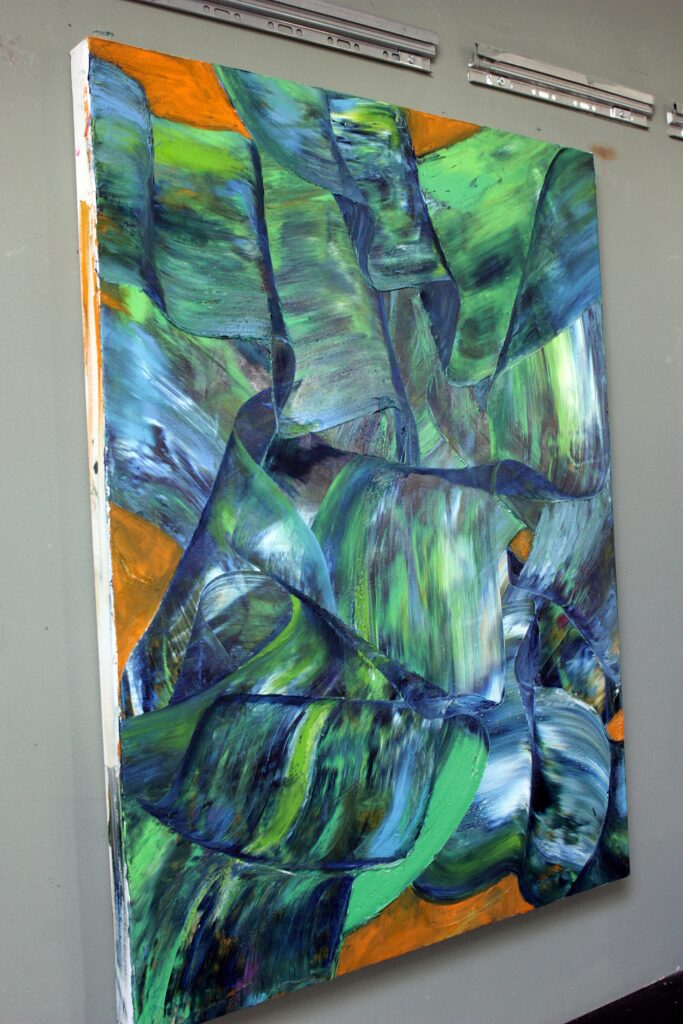
Where can people follow you and find out more?
You can follow my artistic journey on Instagram @giuseppe.pastore_art and on Facebook at The Art of Giuseppe Pastore. For further inquiries or to view my portfolio, feel free to reach out via email at Giupastore80@gmail.com.




Comments are closed.